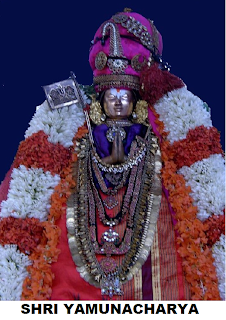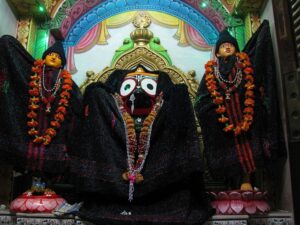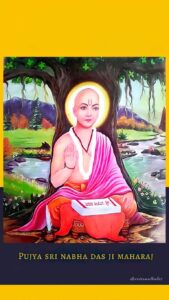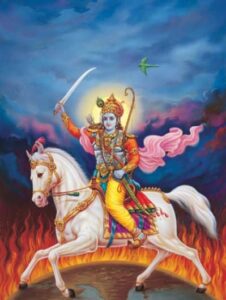Introduction In the south of India, many great devotees have appeared to spread the glories of the Lord. Among them, Sri Ramanujacharya is perhaps the most famous. However, just before Ramanuja, there lived another great Vaishnava whose life and teachings had a tremendous influence on Ramanuja, although the two never met. This was Sri Yamunacharya, also known as Alavandhara, “The Conqueror.” He composed the earliest Stotras of the Srivaishnava Sampradaya.
Birth and Early Life Yamunacharya was born around 918 AD in Madurai, the capital of the mighty Pandya kings. His grandfather was the renowned scholar and devotee Nathamuni, who was also famous for his mystic abilities and expertise in astanga yoga. Nathamuni first compiled the songs of Nammalvar, a famous South Indian devotee, and set them to music.
Nathamuni’s son, Isvaramuni, married a beautiful young woman and traveled with his family to visit holy places in northern India, including Vrindavan, the birthplace of Lord Krishna. Shortly after their return, Isvaramuni’s wife gave birth to a baby boy, who was named Yamuna in memory of the sacred river flowing through Vrindavana. Tragically, Isvaramuni passed away soon after Yamuna’s birth, leaving his young wife a widow. Nathamuni, devastated by the loss of his son, renounced worldly affairs and took up the life of a sannyasi, dedicating himself entirely to the worship of Lord Vishnu. Thus, Yamunacharya was raised by his mother and grandmother in great poverty.
The Challenge At five years old, Yamunacharya began studying under Bhasyacharya and quickly became his teacher’s favorite due to his intelligence and sweet nature. By the age of twelve, he was the best student at Bhasyacharya’s school. During this time, Kolahala (Akkialvan), a great scholar at the court of the Pandya king, was famous for defeating other scholars in debates. The king decreed that any scholar defeated by Kolahala must pay an annual tax or face death. Bhasyacharya, being poor, had not paid the tax for two years.
One day, while Bhasyacharya was away, a disciple of Kolahala came to collect the overdue tax. Yamunacharya, left alone at the school, responded with great respect but also with a challenge. Offended by the contemptuous manner in which his teacher was spoken of, Yamunacharya boldly declared that even the lowest disciple of Bhasyacharya could defeat Kolahala in debate.
Preparations for the Debate Kolahala was amused when he heard that a mere boy had challenged him. However, the Pandya king, intrigued, sent a royal messenger to bring Yamunacharya to the palace. Yamunacharya agreed to the debate but requested a conveyance suitable for a scholar of his standing. The king sent a palanquin and a hundred soldiers to escort him, and Yamunacharya, undaunted, prepared for the debate.
The Contest In the royal court, Kolahala began by posing simple questions to Yamunacharya, who answered them all with ease. When the questions became more difficult, Yamunacharya still replied without difficulty. Eventually, he challenged Kolahala with three propositions that could not be refuted: that Kolahala’s mother was not barren, that the Pandya king was supremely righteous, and that the queen was as chaste as Savitri. Unable to refute these statements without contradicting the scriptures, Kolahala was defeated.
The queen, who had wagered on Yamunacharya’s victory, joyfully proclaimed him the victor. The king, impressed by Yamunacharya’s wisdom, embraced him and offered him half his kingdom. Although only twelve years old, Yamunacharya accepted and ruled his new kingdom with great wisdom and humility.
Meeting with Lord Ranganath Meanwhile, Rama Misra, a disciple of Nathamuni, sought to fulfill his guru’s wish by bringing Yamunacharya to Srirangam. He cleverly arranged to meet Yamunacharya by providing a spinach dish that the king loved and then stopping its supply. When Yamunacharya asked to meet the supplier, Rama Misra revealed Nathamuni’s wish and took Yamunacharya to Srirangam. There, Yamunacharya was moved by the divine beauty of Lord Ranganath and performed saranagati (surrender) at His lotus feet.
Surrender “O you worthy of being sought as refuge! I am not one established in Dharma, nor am I a knower of the self. I have no fervent devotion to your lotus-feet. Utterly destitute as I am, and having none else for resort, I take refuge under your feet.”
— Stotra Ratnam
Rama Misra explained the purpose of his mission, and Yamunacharya took up the mantle of spiritual leadership as YAMUNA MUNI, dedicating his life to spreading the teachings of Sri Vaishnavism.
Prayer “O Lord Hari, please mercifully accept this person who is a storehouse of thousands of offenses, who has fallen into the terrible ocean of repeated birth and death, who has no place to go, and who now begs shelter from You.”
Legacy Yamunacharya’s disciples included notable figures such as MahaPurna, Ghosti Purna, and Peria Tirumala Nambi. He authored several important works, including the Siddhi Trayam, Geethartha Sangraham, and Stotra Ratnam. Before his passing, Yamunacharya appointed Ramanuja as his spiritual successor, establishing the foundation for the future of the Sri Vaishnava tradition.



